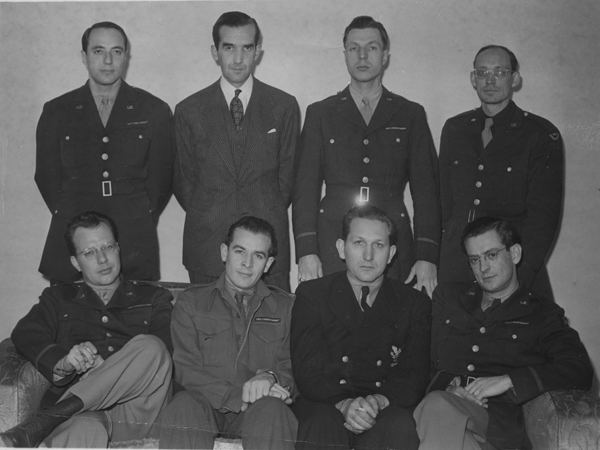 | ||
The Murrow Boys, or Murrow's Boys, were the CBS broadcast journalists most closely associated with Edward R. Murrow during his years at the network, most notably the years before and during World War II.
Contents
- The Original Boys
- Other Murrow associates in Europe
- The Second Generation Boys
- Other colleagues
- References
Murrow recruited a number of newsmen and women to CBS during his years as a correspondent, European news chief and executive. The "Boys" were his closest professional and personal associates. They also shared Murrow’s preference for incisive, thought-provoking coverage of public affairs, abroad and at home. They achieved nationwide fame, and inadvertently became early examples of "celebrity journalism" in the days of radio and early television news.
The Original "Boys"
The journalists most often cited as Murrow’s Boys are those who worked for and with him covering the war for the CBS Radio Network, and who set the highest standards for radio and later TV journalism. Murrow recruited most of them, many of whom worked for the United Press. Their story is the subject of the 1996 book The Murrow Boys, by Stanley Cloud and Lynne Olson.
The nickname's origins are unclear. Cloud and Olson interviewed Janet Murrow and set out to determine who exactly fell under the definition of a "Murrow Boy." They primarily included those hired by or associated with Murrow during World War II, with some exceptions.
The original Boys, and some of their notable CBS beats during the war, included:
Of the original Boys, Hottelet would end up having the longest career at CBS, joining the network in 1944 and continuing to work at the network until 1985. He was the last surviving member of the original group.
The group maintained close ties with Murrow but not necessarily each other. They had significant autonomy in filing reports, and while they had been influential in developing the field of radio news broadcasting, they were reluctant to make the transition to television. The Murrow Boys earned far more working in radio than they could in television, and they resented the process of lights, cameras, makeup, and other aspects of TV broadcasting. By the 1950s their dominating presence in the field had begun to decline.
Despite this, many in the core group stayed with CBS throughout the 1950s. During the McCarthy era, Howard K. Smith, William L. Shirer, and Alexander Kendrick were among those named in the Red Channels.
Other Murrow associates in Europe
Several other CBS journalists worked for and with Murrow during the crisis years in Europe, though they are not mentioned as being in the circle of Boys. They include Bill Shadel, Charles Shaw, Douglas Edwards, John Charles Daly, Paul Manning, George Moorad and Betty Wason. Also included is Edwin Hartrich, who worked under Bill Shirer in Berlin and broadcast daily on CBS through most of 1940; and Ned Calmer, who joined the CBS team in 1940 after working for the European editions of the Chicago Tribune and the New York Herald.
The Second Generation "Boys"
After World War II, Murrow returned to New York and briefly served as CBS’s vice president for public affairs. He maintained close friendships with the correspondents he hired during the war, and spent much of his free time with them. Younger colleagues who Murrow had not played a role in hiring began to feel like outsiders and viewed his relationship with the Murrow Boys preferential treatment. They formed the "Murrow Isn't God Club," which soon disbanded after Murrow asked if he could join.
Murrow recruited several promising journalists in the mold of the original Boys, some of whom became close enough to Murrow that they’re seen as a second generation.
They include:
Schorr stayed with CBS News until 1976. He later joined the CNN, and was a senior news analyst for National Public Radio, often delivering commentaries in the Murrow mold, until his death on July 23, 2010.
Kalb, the last journalist recruited by Murrow to CBS, was joined by his brother Bernard at the network in the 1960s and 70s. The Kalbs later moved on to NBC. Marvin Kalb is now a Fox News contributor and is now a Washington-based senior fellow for Harvard University.
Many journalists, including some at CBS, include these "post-war" associates in the group of Boys, though authors Cloud and Olson limited their own list to the World War II crew.
Other colleagues
Though they are not considered Murrow’s Boys, several other notable journalists worked closely with Murrow during his years at CBS, They include:
Friendly later became CBS News president and even later taught at Columbia University, introducing the Murrow standards to generations of young journalists. Hewitt later worked closely with Williams and Wershba during the early years of 60 Minutes.
